✔ 最佳答案
Your answers are correct.
Molar mass of P₄O₁₀ = (30.97×4 + 16.00×10) g/mol = 283.88 g/mol
Molar mass of PCl₅ = (30.97 + 35.45×5) g/mol = 208.22 g/mol
Molar mass of POCl₃ = (30.97 + 16.00 + 35.45×3) g/mol = 153.32 g/mol
Initial moles of P₄O₁₀ = (15.00 g) / (283.88 g/mol) = 0.052839 mol
Initial moles of PCl₅ = (15.00 g / (208.22 g/mol) = 0.072039 mol
Balanced equation for the reaction:
P₄O₁₀(s) + 6 PCl₅(s) → 10 POCl₃(ℓ)
Mole ratio P₄O₁₀ : PCl₅ = 1 : 6
If PCl₅ completely reacts, P₄O₁₀ needed = (0.072039 mol) × (1/6) = 0.012007 mol < 0.052839 mol
Hence, P₄O₁₀ is in excess. PCl₅ is the limiting reactant.
Moles of P₄O₁₀ left unreacted = (0.052839 - 0.012007) mol = 0.040832 mol
The answers:
Mass of P₄O₁₀ after reaction = (0.040832 mol) × (283.88 g/mol) = 11.59 g
Mass of PCl₅ after reaction = (15.00 - 15.00) g = 0.00 g
Mass of POCl₃ after reaction = (15.00 + 15.00 - 11.59) g = 18.41 g
====
OR:
If P₄O₁₀ is the limiting reactant:
(15.00 g P₄O₁₀) × (1 mol P₄O₁₀ / 283.88 g P₄O₁₀) × (10 mol POCl₃ produced / 1 mol P₄O₁₀) × (153.32 g POCl₃ / 1 mol POCl₃)
= 81.01 g POCl₃ produced
If PCl₅ is the limiting reactant:
(15.00 g PCl₅) × (1 mol PCl₅ / 208.22 g PCL₅) × (10 mol POCl₃ produced / 6 mol PCl₅) × (153.32 g POCl₃ / 1 mol POCl₃)
= 18.41 g POCl₃ produced
Because the complete reaction of PCl₅ produces the smaller amount of the product, PCl₅ is the limiting reactant.
Mass of P₄O₁₀ after reaction = (15.00 + 15.00 - 18.41) = 11.59 g
Mass of PCl₅ after reaction = 0.00 g
Mass of POCl₃ after reaction = 18.41 g
